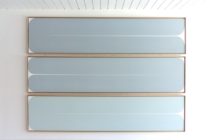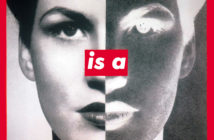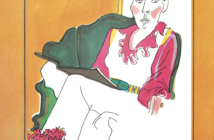Dear Artist,
Last Tuesday, at home in the south of France, Henri Cartier-Bresson, one of the world’s best-known photographers, died. He was 95.
“One eye looks within, the other eye looks without,” said Cartier-Bresson. Starting with the simplest of box cameras, most of his life he worked in black and white with a quiet Leica, without a flash. He didn’t believe in cropping, staging, tricky developing or dodgy printing. His business was trapping the momentary visual delights of life in motion. “For me, the camera is a sketchbook, an instrument of intuition and spontaneity, the master of the instant which, in visual terms, questions and decides simultaneously. In order to give meaning to the world, one has to feel oneself involved in what he frames. This attitude requires concentration, a discipline of mind, sensitivity, and a sense of geometry. It is by great economy of means that one arrives at simplicity of expression. To take photographs is to hold one’s breath when all faculties converge in the face of fleeing reality. It is at that moment that mastering an image becomes a physical and intellectual joy.”
Cartier-Bresson’s concept of “the decisive moment” is as valid for painters as it is for photographers. In photography it means the point in a shooting cycle where the very height of an action is recorded. Paintings also benefit from those times when a cloud forms to echo a foreground motif, where chance body-language signifies meaning, where pictorial elements line up or become separate from one another, where a sitter’s look suddenly gives away an inner being. Even “still-life” can profit from the idea of decisive moment. If you don’t believe me, try looking at a set-up of apples and oranges on a lazy Susan by turning it slowly. You’ll find an ideal, perhaps a perfect angle, and very often it will not be what you originally conceived. It’s all about waiting, seeing, feeling and capturing.
Starting out as a painter, it was to painting and drawing that Cartier-Bresson returned in later life. To him the two arts were complementary, mutually reinforcing–one slow, one speedy–both were a matter of “putting one’s head, one’s eye and one’s heart on the same axis.”
Best regards,
Robert
PS: “Photography is a way of shouting, of freeing oneself, not of proving or asserting one’s own originality. It’s a way of life.” (Henri Cartier-Bresson, 1908-2004)
Esoterica: Cartier-Bresson was early aware of the divide between art-making and art-showing. In Paris in 1947 he co-founded Magnum Photos, an international image bank that aimed at getting quality photography in front of people. Working the synergy between magazines, art books, public and commercial galleries, he raised the awareness and value of his and others’ work. Many of his photographs are among the popular images of our time and have influenced many living photographers and painters.
Henri Cartier-Bresson (1908 – 2004)
Movement of the observer
by Warren Criswell, Benton, AK, USA

“Still Life with Cell Phone”
sepia, black & white chalk on tan paper
work in progress
by Warren Criswell
Regarding “decisive moment” in still life painting, my experience is, as in your lazy Susan example, it’s my own movement that seems to determine the composition. In fact, I can’t set up a still life at all. I have to be taken unawares by the objects, ambushed by them, and any attempted “improvement” of them invariably fails. It takes on the same sort of artificiality for me as Cartier-Bresson must have felt about tricky developing. There’s a window of opportunity in still-life painting–especially the kind I do, of stuff found around the house. Boxes get moved, bananas rot or get eaten, etc.you have to work fast. But the window I’m talking about is much smaller than that, and it opens and closes as fast as a camera’s shutter. The “momentary visual delights of life in motion” in this case is the movement of the observer, me, the accidental movement of my line of vision, encountering some ordinary group of objects in a certain light. It’s usually the light that does it, I think. It’s this rare and somehow profound moment of time that I like to think I’m recording. And for me it’s a fleeting moment: If I don’t do a drawing immediately, if only a brief sketch, it’s gone. So, as Cartier-Bresson used his camera as a sketchbook, I guess I use a sketchbook as a camera.
Speedy focus for decisive moment
by Linda Blondheim, Gainesville, FL, USA
As a painter I’ve often experienced the decisive moment. To me it is not about finding the best view. It is somewhere in the actual painting process where critical decisions must be made. In that decisive moment, the painting will be extraordinary or ho hum depending on those decisions in the painting process. I have seen other plein air painters who will take considerable time to find just the right spot to paint before settling down to work and others who are painting in less than two minutes of arrival. Often, it is the painter who sets up immediately who does the best work. They are able to focus immediately and make good choices in decisive moments.
Don’t wait for perfect conditions
by Todd Plough, Napoli, NY, USA
What we must remember when making a photograph is that the viewer will likely not have the benefit of our breezes, fragrances, sounds, temperature or the heat of the sun on their face. In short a photo must make the viewer feel all the senses with one. Art is the residue of thought — it does not happen by accident or without effort. Let it flow without evaluating it. After you have something before you, only then select what thrills you. This is your mirror. Do not be concerned with what you cannot do, rather know what you can do and do that like Hercules! If you wait for perfect conditions you will never start anything.
Media stops time
by Elizabeth Azzolina, Cherry Hill, NJ, USA
A captured image, whether photograph or painting, channels you to a specific moment of time and emotion. Just the act of flipping through old photos or gazing at a particular painting will put you back to your childhood, a summer vacation or a quiet get together. Photography and painting are tangible processes for holding on to our treasured times of life. Life is fleeting, but with these media, we can stop time in its tracks. And if even for a second, we can take another look. Specific events in our lives drive us to recreate our experiences through imagery. The permanency of these media allows us to reflect on the moment and ourselves. Photographs and paintings are mirrors of many heartfelt memories.
The eternal lover
by Linda Saccoccio, Santa Barbara, CA, USA
Henri Cartier-Bresson’s quote translated to this: Painting is a way of communicating, of liberating oneself, not a place for the ego to prove itself, but for the Self to be discovered. Painting is a way of life. I also like the balance of his quote, “One eye looks within, the other eye looks without.” I am always a gatherer, an observer of my world and experiences, and at the same time when I work painting I allow the inner states of my being the free reign of putting it all together as it chooses. It is connecting the outer and the inner with the mystery of the unknown or unknowable, that reveals the visual statement with awe. Cartier-Bresson’s work has that presence that is poignant, beautiful and deliciously fresh. It reveals a wisdom and ability for presenting those moments in time when we lose our small self to an expansive depth of union. Looking at his work I am immediately drawn in and at home with those moments in life that sweep me away. They evoke the eternal lover who is the artist.
Promiscuous muse
by Mary Klotz, Woodsboro, MD, USA

untitled 3 pieces, oil, triaxial weaving, dye painted wool and traditional rug hooking, wool
by Mary Klotz
I have a promiscuous muse. My muse wants to at least dance with everyone — like a John Paul Jones where switching partners is the standard. And sometimes, she wants to go on a second date — or go straight to the nakedness. That is to say, my muse wants to own every color, work in many media, and in numerous genre. Sometimes just a flirtatious look is enough (I’ll read about etching, for instance). Sometimes there is hip grinding involved, and telltale stains in the studio afterward. Even if a fling is short lived, you get a juicier, more worldly muse afterward. In the craft world, this is frowned upon — one is regarded as having a lack of focus. The art world seems to better embrace a person who makes some sculpture, paints, draws — it’s all considered part of the great dance. So, if your mojo is missing, are you squeezing your knees together? Are you telling yourself you must stick to one partner? Are you declining invitations to the dance? Dally with a few new partners — at worst they’ll make your old familiar partner(s) look good.
Chess moves for art training
by Henk Jelsma, Netherlands
These days I’m working with digital photography in combination with traditional tools. I rebuild old work into new work, but I used to practice “paint by seeing paint” for at least one year — just painting for the paint. I also played a lot of chess during that period. In chess you learn that in all your potential moves there is just one move that ends up ruling your game. As you can’t go back, this is excellent training.
Studio toys
by Barbara Lloyd, Austin, TX, USA
I have toys in my studio and when I need a break I put on some dance music and tap, or fling a yo-yo a few times or beat on a bongo or table top, anything to break the spell of “I can’t do it.” Yes, it’s fun as well as therapeutic. And, then there are the times when I pray for perseverance and skill to finish and focus so I can meet a deadline.
Watch your mouth
by Laurie DeMatteo
Self-talk is destructive to art, as I understand it. In the making of art we are channeling energy from a source to a visual. Talking, even to self, redirects the energy channel to a less pure interpretation. Over time, experience will think you through the technicalities, the language will surface not as a language but a translation, a message.
Turn them both upside down
by Gail Guenther, New Jersey, USA
A useful idea is to turn both your reference (generally a photo) and your painting upside down and check to see that you have your shapes right, and your lights and darks right, and your colors right. What happens is that turning the painting upside down, tricks your eye and allows you to see what is really in the photo almost like an abstract. You can also double check your “negative” spaces. Those are the spaces between the other things you are painting, like between the horse’s legs or between the arm of the cowboy and the horse’s neck etc. Use that entire triangular area as a shape, and see where it might be off in the painting. Check the length of one against the length of the other. Our mind likes to paint what it thinks our eye sees, but so many times we are fooled.
Building connections
by Sigrid Tidmore, Tampa, FL, USA
When I was a young designer, I was frequently daunted by the belief that all my ideas had to be totally new and never been done before. It took me a while to understand that synthesis is the way most innovation happens in nature. It’s perfectly legitimate to build on the good ideas of others, particularly when you’re still exploring the territory. That’s the great thing about web-thinking. It takes your current ideas and builds new connections.
Wanted: Students with spark
by Norma Hopkins, Bolton, Lancashire, England
I’m a textile Artist. My degree is in Embroidery. I have been a teacher for 20 years. Art schools in England expect to be shown prospective students’ potential. They want students to possess this spark so that they can help the student to realize their ideas through the thinking process that the colleges generate. They need this spark to light a fire under the process that they use to develop their students. All their education can never make up for the lack of it.
Sharing, not preaching
by Tatjana Mirkov-Popovicki
I find that I greatly benefit from reading about the methods and thoughts of other artists — those are the letters of the type “this is how I do it, and here’s a sample of my work.” Wonderful — this is a unique opportunity to learn from many artists. The other type of letter, such as, “the artists must/must not/ do, whatever, or they will always create good/bad art,” are not only of no use to me, but also don’t reflect well on the authors. In my opinion, the difference is in sharing versus preaching. Sharing works for me. However, I don’t have a problem with some preaching by the proved geniuses of the past — your Resource of Art Quotations is a great resource for that.
Odd request dept.
by Lucey Woodward, UK
I wonder if you can help me. My husband and I have been given a picture as a wedding present of a kangaroo in shorts and a hat and the name in the top right corner says “Splodge.” To be honest we are currently going through a divorce and we wondered if the picture was actually worth anything. It was sent over to us from Australia and so far having no luck. I know it’s a shot in the dark, but I wonder if you could point me in the right direction.
(RG note) These days it seems more and more we’re getting odd requests for information. So much so that I often think some people are putting us on. These I generally refer to Andrew to answer directly. In this case I felt I had to respond because Lucey and her divorcing husband are in luck. Norman L. Splodge (1942-1985) was one of the best known of the Australian “Kangaroo in Shorts” genre. Known for actually boxing with the giant marsupials he gained popularity on the show circuit along with Crocodile Dundee. On losing his touch at contact sports he took up painting where his celebrity status propelled his prices. Of particular value are the ones where he shows Joey sticking out of the pouch (just above the shorts). If Joey is wearing shorts too (particularly boxing shorts) you can add a premium. I suggest you phone Sothebys soon. Unfortunately Splodge died relatively young while attempting to make a comeback in the ring. He should have stuck to art.

St Margaret’s Chapel acrylic painting |
You may be interested to know that artists from every state in the USA, every province in Canada, and at least 115 countries worldwide have visited these pages since January 1, 2004.





















1 Comment
Using this camera to capture heroic matches in a small world cup is truly amazing.